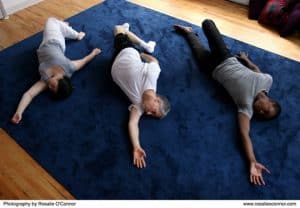
Ever notice how during times of heightened stress that your back — or neck or shoulders or wherever you hold tension — acts up? Well, that’s exactly what just happened to me.
Lately I’ve been feeling like a stress magnet. Concerns about health, finances, home, family (all the biggies) have been building up. The back is where I store my stress and tension, and it let me know I had too much. My back “imploded.” Ouch!
It’s true that when the pain smacked me in the back I was picking up a pile of books, but I know that the true culprit is the extra stress that I’ve not been handling well.
How can stress affect our bodies?
The mind and body are not separate. With every thought or feeling there is a bodily component.
As an example, think of a time recently when you were upset. Take a minute to fully imagine what it was like. Notice what subtle sensations you feel in your body. Perhaps your breath stops, or your chest, belly, or back might tighten.
Now think of a time when you were happy, maybe engaged in a favorite activity or in a favorite place. Again take time to recreate that experience in your mind. Notice your body. What changes? Perhaps your shoulders relax or your breath deepens. Everyone’s experience is different. What is it for you?
The mind and body are one in the same.
Moshe Feldenkrais says it succinctly in “The Brain’s Way of Healing,” by Norman Doidge: “I believe that the unity of mind and body is an objective reality. They are not just parts somehow related to each other, but an indispensable whole while functioning.”
He continues, “The idea of two lives, somatic and psychic, has … outlived its usefulness. The brain is always embodied, and our subjective experience always has a bodily component, just as all so-called bodily experiences have a mental component.”
What can you do when your back “implodes”?
The first simple but super important step is to notice what happened. When I gave a little thought to my situation, I realized that the true instigator of the “implosion” wasn’t that pile of books but my inability to integrate and manage the stress in my life.
Understanding that stress is the culprit does not give you license to be hard on yourself for letting that happen! It took some tears of frustration before I could just allow myself to acknowledge how things were rather than pounding on myself about my mistakes and lack of attention. Pain is real. Be gentle on yourself!
Finally, it is critical to keep moving. Now, that first day I couldn’t move at all without excruciating, searing pain. So I did microscopic movements. Perhaps one could even say I imagined moving just the teensiest bit. By the second day, I could move — only very carefully and with help — and take Epsom salt baths. And as I was spending the majority of time on the floor (bed was too squishy), very small, tiny movements helped keep my back from stiffening further.
Gentle movements to help back pain
My favorite movement for back pain is to lie on my back with knees bent and super softly tilting knees side to side, and rolling my head first with the direction of the knees and then in the opposite direction.
Another movement that can offer relief after several days have passed is done while sitting on a chair with elbows on knees. Very gently you round and arch your back. It’s easier to understand if you see it done. Watch my demonstration.
Stress happens. Backs react. It happens to all of us — even Feldenkrais® practitioners! It helps to recognize, though, that pain can be a clue that the whole body is reacting to stress. It’s worth paying attention to how life’s stressors may be building up inside you so your back doesn’t have to “implode” to get your attention.
Are you ready to relieve your pain and learn how to move with more comfort?
Stop by a class any Tuesday at Songbird from 9:30-10:30am.
Find out more about Susan Hammond, Guild-Certified Feldenkrais practitioner.

